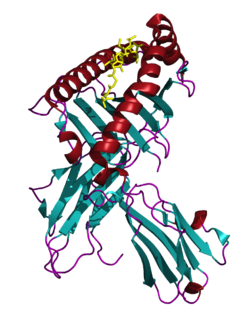Clinical significance
MART-1/melan-A is a protein antigen that is found on the surface of melanocytes. Antibodies against the antigen are used in the medical specialty of anatomic pathology in order to recognize cells of melanocytic differentiation, useful for the diagnosis of a melanoma. The same name is also used to refer to the gene which codes for the antigen.
The MART-1/melan-A antigen is specific for the melanocyte lineage, found in normal skin, the retina, and melanocytes, but not in other normal tissues. It is thus useful as a marker for melanocytic tumors (melanomas) with the caveat that it is normally found in benign nevi as well.
In many immunological studies melan-A peptides serve as a positive control for T-cell priming experiments. This is due to the fact that its high precursor frequency of about 1/1000 among cytotoxic T-cells makes it easy for antigen presenting cells to evoke peptide-specific responses. [8]
This page is based on this
Wikipedia article Text is available under the
CC BY-SA 4.0 license; additional terms may apply.
Images, videos and audio are available under their respective licenses.







